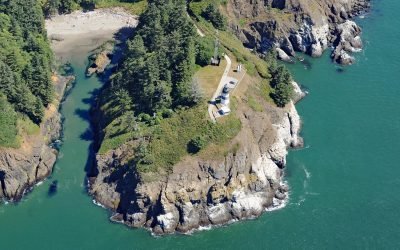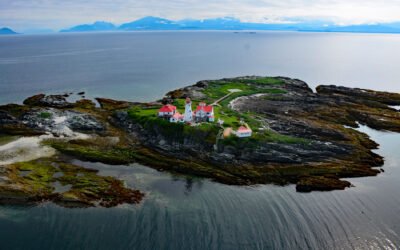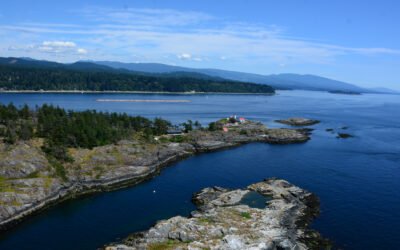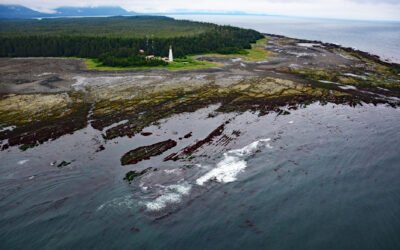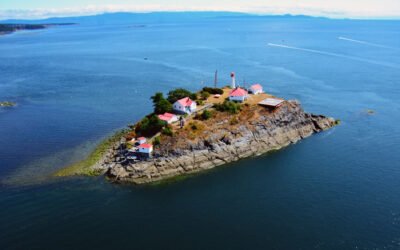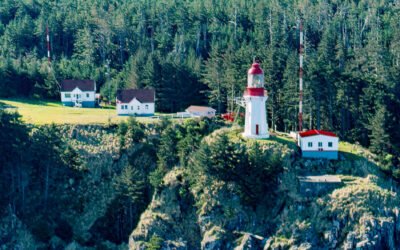Lighthouses
Recent Articles
More Articles
Cape Disappointment, Columbia River
Cape Disappointment is a prominent headland and navigational landmark with a historic lighthouse on the north side of the Columbia River, 12 miles (19 km) northwest of Astoria, and 2.2 miles (3.5 km) south of Ilwaco, Washington.
Cape Saint Elias, Kayak Island
Cape Saint Elias comprises a prominent headland and Pinnacle Rock, and is the site of a historic lighthouse at the southwest end of Kayak Island, 172 miles (277 km) west of Yakutat and 62 miles (100 km) southeast of Cordova, Alaska.
Eldred Rock Lighthouse, Lynn Canal
Eldred Rock is a small island and site of a historic lighthouse situated adjacent to Sullivan Island in Lynn Canal, between the Chilkat Range to the west and the Kakuhan Range to the east, about 55 miles (89 km) northwest of Juneau and 20 miles (32 km) south-southeast of Haines, Alaska.
Green Island, Chatham Sound
Green Island is part of the Dundas Island Archipelago situated on the west side of Chatham Sound and is the site of a historic lighthouse, about 65 miles (105 km) south-southeast of Ketchikan and 24 miles (39 km) northwest of Prince Rupert, British Columbia.
Merry Island, Malaspina Strait
Merry Island is situated at the southern entrance to Welcome Passage in Malaspina Strait, between the Thormanby Islands to the west and the Sunshine Coast, about 39 miles (63 km) west-northwest of Vancouver and 3 miles (5 km) south of Halfmoon Bay, British Columbia.
Estevan Point, Hesquiat Peninsula
Estevan Point is the site of a historic lighthouse at the end of the Hesquiat Peninsula which forms the southern entrance to Nootka Sound on the west coast of Vancouver Island, about 35 miles (56 km) southwest of Gold River and 33 miles (53 km) northwest of Tofino, British Columbia.
Chrome Island, Baynes Sound
Chrome Island is located 0.15 miles (0.24 km) south of Boyle Point Provincial Park, on the southern tip of Denman Island, and is the site of a historic lighthouse that marks the southern entrance to Baynes Sound, about 72 miles (116 km) west-northwest of Vancouver and 2 miles (3.2 km) east-northeast of Deep Bay, British Columbia.
Langara Island, Haida Gwaii
Langara is the northernmost island of the Haida Gwaii archipelago and the site of a historic light station that marks the southern boundary of Dixon Entrance, about 94 miles (151 km) southwest of Ketchikan, Alaska and 38 miles (61 km) west-northwest of Masset, British Columbia.
Browns Point, East Passage
Browns Point is a conspicuous landmark in Puget Sound located at the southern end of East Passage and at the entrance to Commencement Bay, about 21 miles (34 km) south-southwest of Seattle and 4 miles (6.5 km) north of Tacoma, Washington.
Point Robinson, Maury Island
Point Robinson is the eastern point of Maury Island in Puget Sound and the site of a historic lighthouse, about 15 miles (24 km) south of Seattle and 10 miles (16 km) north-northeast of Tacoma, Washington.
About the background graphic
This ‘warming stripe’ graphic is a visual representation of the change in global temperature from 1850 (top) to 2019 (bottom). Each stripe represents the average global temperature for one year. The average temperature from 1971-2000 is set as the boundary between blue and red. The colour scale goes from -0.7°C to +0.7°C. The data are from the UK Met Office HadCRUT4.6 dataset.
Click here for more information about the #warmingstripes.

